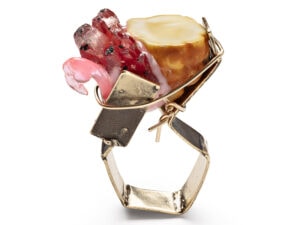Edith Sitwell had a dissonant, resonant, voice that she employed to recite her avant-garde poetry—most notoriously Façade (1923), performed to Sir William Walton’s modernist music via Sengerphone (a megaphone made of papier-mâché) jutting through the open mouth of a primitivist mask, painted by sculptor Frank Dobson, on a curtain, which concealed her six-foot body. The production was so outrageous that Noël Coward walked out, while Virginia Woolf sat bemused.
Born into an aristocratic, albeit dysfunctional, British family, Sitwell learned early that emotional endurance depended upon spinning her perceived deficiencies into assets. Rejected by both a remote, priggish father and a hysterical, pleasure-seeking mother, she possessed a spinal deformity as well as deeply set eyes and a long, high-browed visage upon which a huge, beaky nose stood prominent. Instead of receding into the background, Sitwell made the most of her physical eccentricities to attract much-needed attention. She wore flowing, theatrical garments and legions of enormous jewelry. Irish novelist Elizabeth Bowen described Sitwell as “an altar on the move.”[1] She was painted by Wyndham Lewis, Roger Fry, and Pavel Tchelitchew and admired for her unconventional style by photographers Horst P. Horst and Cecil Beaton, each of whom shot numerous, compelling portraits of her.
With eclectic indulgence, Sitwell mixed fashions medieval to modern—her costume exuding drama, if not gentility. Gigantic jewels were protection against insecurity and complemented the gowns, robes, and headdresses festooning her statuesque frame. She combined all sorts of jewelry styles, with rings, arguably, her favored format. Believing her graceful, attenuated fingers to be her best characteristic, Sitwell stacked two rings—featuring monstrous aquamarines—on the fourth finger of each hand, titling them Wages of Sin. “My hands are my face,” she wrote, “I feel undressed without my rings.”[2] She also donned massive brooches, set with precious and semiprecious stones, while on her wrists she sported sizable bracelets from alluring locales such as Yemen and draped ethnic belts around her neck like Renaissance chains of office. One of her most distinctive necklaces—Aztec—was made for her by Taos, New Mexico, socialite and jeweler Millicent Rogers. Based upon a pre-Columbian pectoral, it was so sonorous that, Sitwell wrote, “I have to be careful of the clanking when I am reciting and don’t often wear it for that.”[3]
After a melancholy life which, nonetheless, included friendships with Gertrude Stein, Dylan Thomas, and Marilyn Monroe, Edith Sitwell died of heart failure in 1964, at age 77, an increasingly paranoid alcoholic. Hers was a complex personality, but one that knew how to survive and, at least artistically, thrive. Jewelry was a dominant part of Sitwell’s strategy, giving her confidence in her appearance and, through a style reminiscent of the Middle Ages, a palpable connection to her proud ancestry from the illustrious House of Plantagenet. Jewelry also provided ties to beloved younger brothers Osbert and Sacheverell, who would bring back stones from their exotic travels to be mounted in pieces. Three rings and a pair of gold-plated French expansion bracelets are on loan to London’s Victoria and Albert Museum. While she lived, jewelry was Sitwell’s armor, and she flaunted it with gusto. Life is better, she mused, “with all banners flying.”[4]

[1] In William Sitwell, “Edith Sitwell, Eccentric Genius,” The Telegraph, March 11, 2011, http://www.telegraph.co.uk/culture/books/biographyandmemoirreviews/8373893/Edith-Sitwell-eccentric-genius.html.
[2] Little Augury, “Decorating Edith With Diamonds and Rhubarb,” Little Augury, March 28, 2010, http://littleaugury.blogspot.com/2010/03/decorating-edith-with-diamonds-and.html.
[3] Ibid.
[4] Alexandra Harris, “Edith Sitwell: Avant Garde Poet, English Genius by Richard Greene—Review,” The Guardian, March 4, 2011, http://www.theguardian.com/books/2011/mar/05/edith-sitwell-richard-greene-review.




